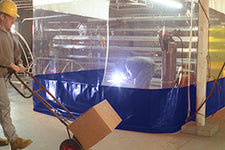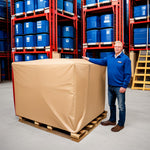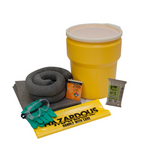How to Choose the Right Construction Netting
All construction sites have something common: construction debris netting. It’s the most effective netting in preventing accidents caused by falling debris. That’s why this specific netting has gained construction managers’ attention for many years. But here’s the challenge: not all construction debris netting options are the same.
Substandard netting might look quite similar to high-quality construction debris netting. It might also be available at a low price. But you never know how quickly it starts deteriorating while increasing the chances of workplace injuries and even legal issues leading to heavy fines. That’s why it’s essential to choose only the best construction debris netting.
Choosing a durable netting for construction sites can be tricky. You need to know several key points before selecting the right one. We have made it easy for you by explaining all of them in this guide.
Let’s explore the eight factors you should consider before buying a construction debris netting that lasts for years.

1. Analyze the type of construction project
Debris netting for construction sites varies depending on unique construction purposes. Constructing a high-rise building, for instance, requires a debris netting that’s heavy-duty and robust – it should be able to help prevent heavy debris (including concrete, wood, and even metal) from falling off the work area. The same goes for construction sites that also deal with demolition.
On the contrary, a residential construction project requires a lightweight debris netting that can prevent small particles of concrete, dust, and plaster from entering urban areas. So, consider the nature of the construction project you need debris netting for, and select one accordingly. Keeping the purpose and type of your construction project in mind will also enable you to make a cost-effective decision.
2. Consider OSHA’s safety regulations
Occupational Safety & Health Administration (OSHA) has set laws to minimize the occurrence of workplace injuries at construction sites. It requires employers to install construction debris netting that adheres to its specific standards. Here are some of the standards set by OSHA:
- The size of the mesh should be 6x6 inch or less than that.
- The netting should have an extended space to cover the outermost surface of the work area.
- The netting should also have safety hooks at the time of installation
These are just a few of OSHA’s guidelines for construction sites. Make sure to follow the remaining construction safety standards to avoid any unfavorable consequences in the form of penalties, legal claims, or repair costs.
The objective is to choose the netting that’s strong enough to avoid any falls or mishaps. When selecting construction debris nettings, OSHA also suggests employers to have a certification specifying that the netting complies with its construction safety standards. Therefore, you should ask the manufacturer if the construction debris netting is certified to OSHA safety compliance.
3. Match the construction debris netting material with construction requirements
Construction debris nettings must possess high-strength material to ensure increased level of performance. That’s why employers should prefer fire-retardant construction debris netting to achieve maximum safety at construction sites.
Look for the one made of high-density polyethylene. This netting material is flame-retardant, UV-resistant, lightweight, and durable as it’s infused with additives that have fire-retardant properties. It also meets specific standards for fire safety (including NFPA 701). This makes polyethylene the most preferred material for debris construction netting.
Polypropylene and polyester are some other options. Whichever material you prefer, make sure that the material is chemical-resistant, tear-resistant, and weather-proof.
4. Go deeper into technical specifications
Specific features of construction debris netting reveal a lot about its functionality. While considering one, you can look for these specifications:
- Knitting: nettings made of knitted polyethylene provide tear resistance, enhanced flexibility, and higher durability. So, look for polyethylene that’s 100% knitted.
- Mesh size: mesh with smaller openings effectively contains dust, insulation particles, and fine debris without disrupting airflow.
- Shade factor: this feature determines the amount of light a debris netting is designed to block. The shade factor should be around 55% to 60% so it can block UV rays while still allowing some air for ventilation.
- Fire resistance: fire-resistant nettings are ideal for construction projects in which welding is involved.
- Hemmed corners: the edges should be hemmed as well as reinforced to prevent any damage.
5. Consider environmental challenges
Construction debris nettings must perform well even in extreme weather conditions. Therefore, you need to act proactively and choose the netting that suits the climate.
On rainy days, construction debris netting exposed to prolonged moisture can sag, attract mold, or weaken over time. If you have an ongoing construction project in a rainy season, you should look for construction debris netting with water-resistant material (such as high-density polyethylene) as it repels water.
In freezing weather, ice accumulation or heavy snow adds extra weight to the debris netting. This may lead the netting to tear or collapse. To avoid this situation, look for heavy-duty construction debris netting that can handle extra weight. The material should also be ice-resistant that can prevent stiffening or cracking of the netting.
6. Consider the cost
While affordability matters when choosing a construction debris netting, you should give a higher emphasis to quality, compliance, and durability. Therefore, focus on the specific requirements of your construction project first.
You can choose lightweight construction debris nettings for small-scale construction projects. These nettings are more economical. However, you should select heavy-duty construction debris netting for long-term projects. It might have a high initial cost but it will save you from spending on frequent replacements. You should also consider labor costs associated with installation.
7. Inquire about the installation of construction debris netting
Looking at the specifications of a construction debris netting will help you analyze if it offers easy installation features. User-friendly installation options minimize the time and effort that’s going to be spent on setting it up. This also requires fewer workers, and thus, lowers overall labor costs. So, choose the netting with hooks, loops, reinforced borders, and pre-installed grommets.
A construction debris netting can be re-installed in a different work area (after you have utilized it for a short-term project). In this situation, you can transport and install the same netting at another construction site. But before choosing the netting, pick the one that’s available in a roll size that’s manageable and easily transportable to other work areas.
8. Consult an expert before buying in bulk
It’s always a good idea to opt for an expert opinion before purchasing a construction debris netting. You can communicate your construction project details to reputable manufacturers. Let them know about the type of debris your construction site is exposed to. Also, specify if environmental factors are a concern.
Since construction debris netting manufacturers have extensive product knowledge, they can suggest a debris netting that’s also compatible with various scaffoldings. They might also offer a discount if you are planning to buy construction debris netting in bulk.
The Takeaway
Various businesses are coming up with innovative solutions to minimize the occurrence of fire hazards, falls, and injuries in the construction industry. Similarly, choosing the best construction debris netting also makes sense when it comes to helping construction workers avoid falls and accidents. However, selecting high-quality construction debris netting can make a big difference if you want to provide long-term safety to construction workers, construction equipment, and other assets.
Once you have purchased fire-retardant construction debris netting, it’s time to focus on its longevity. Conduct weekly inspections of the netting and look for any holes or tears. If you find any small tears, you can consult the experts for repair. But make sure to replace the entire netting in case of large damages.


























